Evaluation of Groundwater Potential Using Aquifer Characteristics in Urambo District, Tabora Region, Tanzania
Abstract
:1. Introduction
2. Materials and Methods
2.1. Description of the Study Area
2.2. Climate
2.3. Geology and Hydrogeology
2.4. Data Collection
2.4.1. Execution of Pumping Tests
2.4.2. Water Sample Collection and Measurement of Physico-Chemical Parameters
2.4.3. Lithology and Hydrogeological Cross-Section
2.5. Pumping Test Analysis and Interpretation Methods
2.5.1. Transmissivity Analysis
2.5.2. Specific Capacity
2.6. Charactrizaion of Physical Parameters in the Water Samples
2.7. Lithological Log Analysis and the Development of Cross-Sections
2.8. Integration of Datasets for Assessing Groundwater Potentiality
3. Results
3.1. Physico-Chemical Parameters in the Water Samples
3.2. Pumping Test Results
3.3. Development of Thematic Layers
3.3.1. Geology
3.3.2. Transmissivity
3.3.3. Specific Capacity
3.3.4. Wells Yield
3.3.5. Total Dissolved Solids (TDS)
3.3.6. Static Water Level
3.4. Lithological Logs
4. Discussion
4.1. Characterization of Groundwater
4.2. Groundwater Occurrence
4.3. Groundwater Flow Direction
4.4. Hydrogeological Cross-Section
4.5. Groundwater Potential Index Map and Validation
5. Conclusions
6. Recommendation
Author Contributions
Funding
Data Availability Statement
Acknowledgments
Conflicts of Interest
Appendix A. Meteorological Data
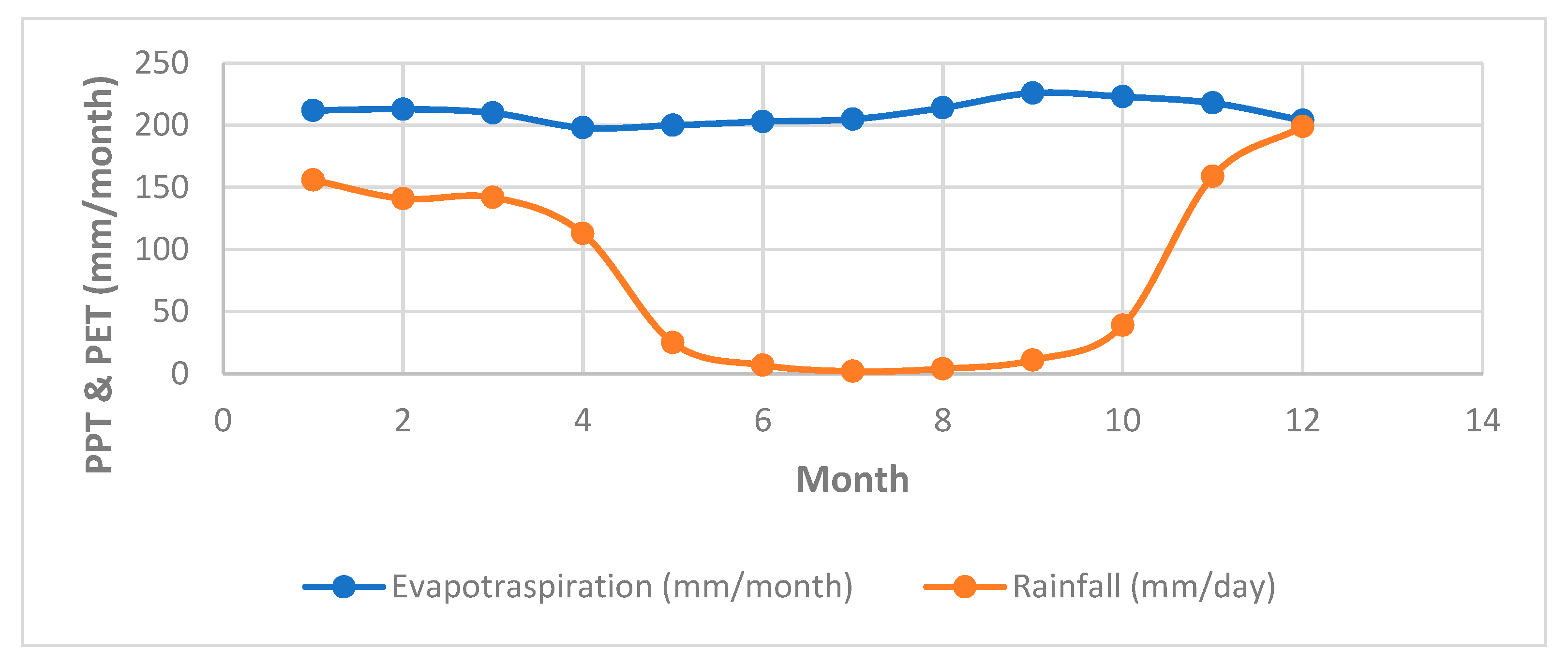
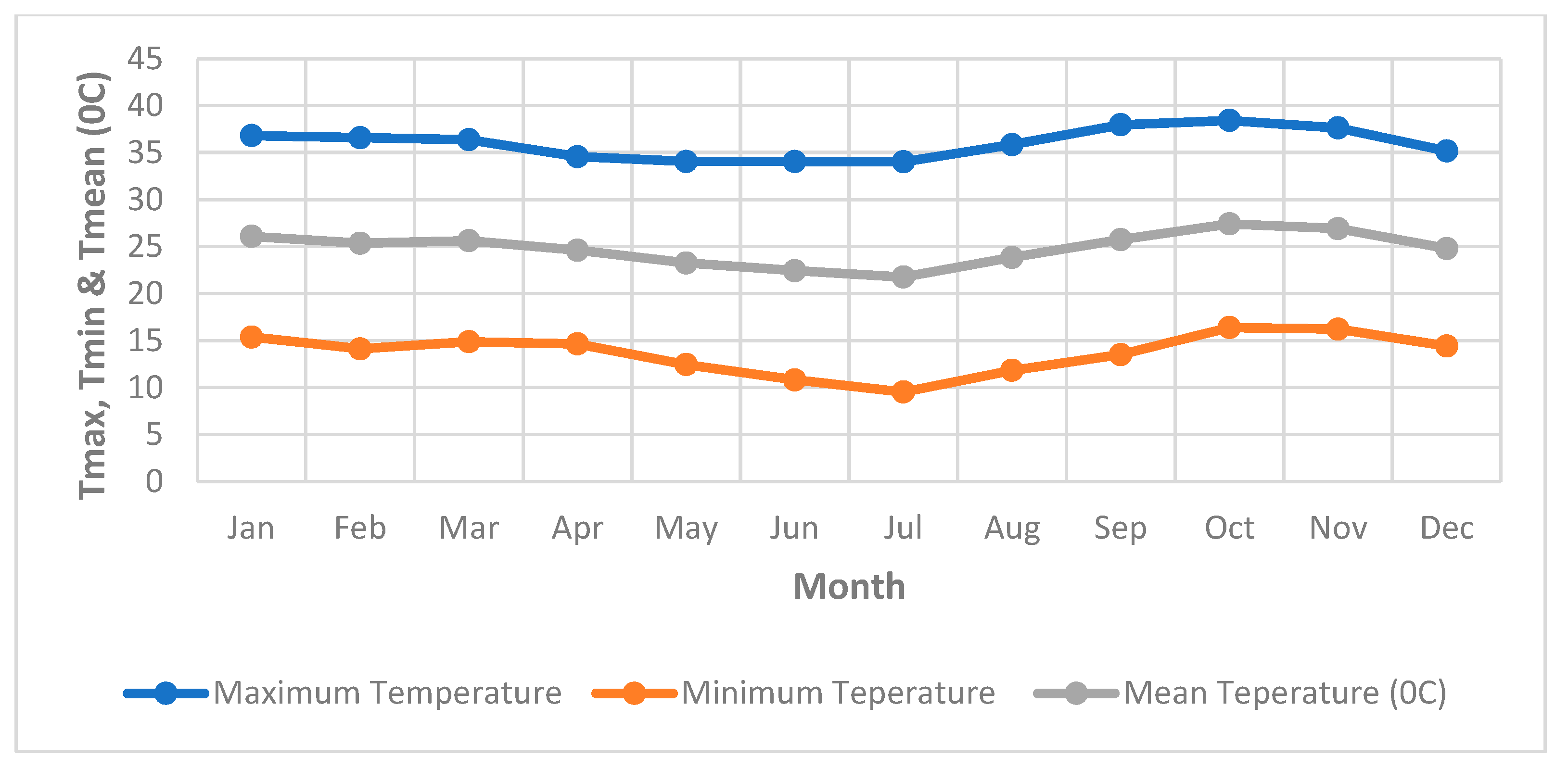
Appendix B. Pumping Test Results as Interpreted by the Cooper and Jacob Method


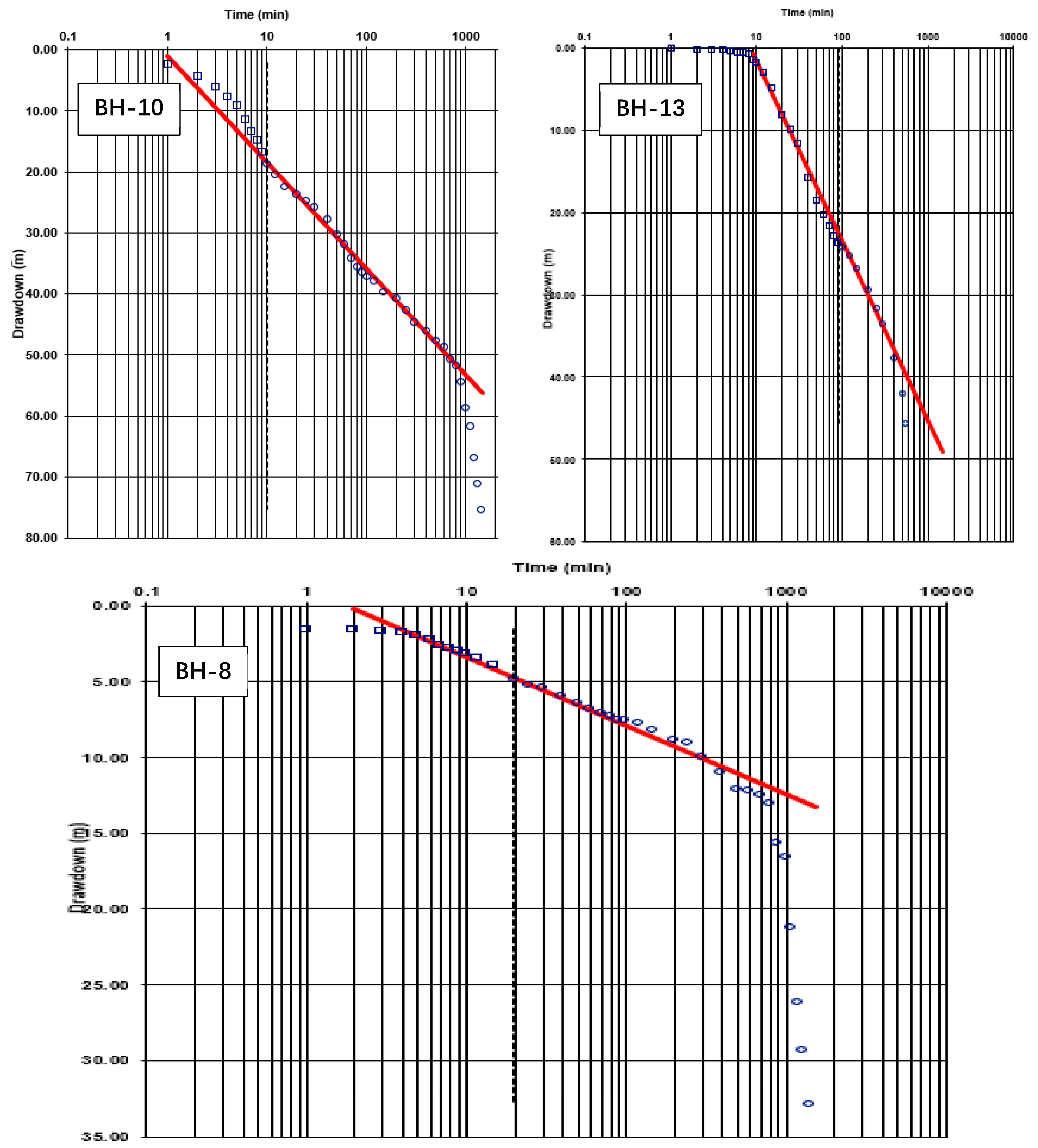
Appendix C. AHP Weighing Procedures and Results
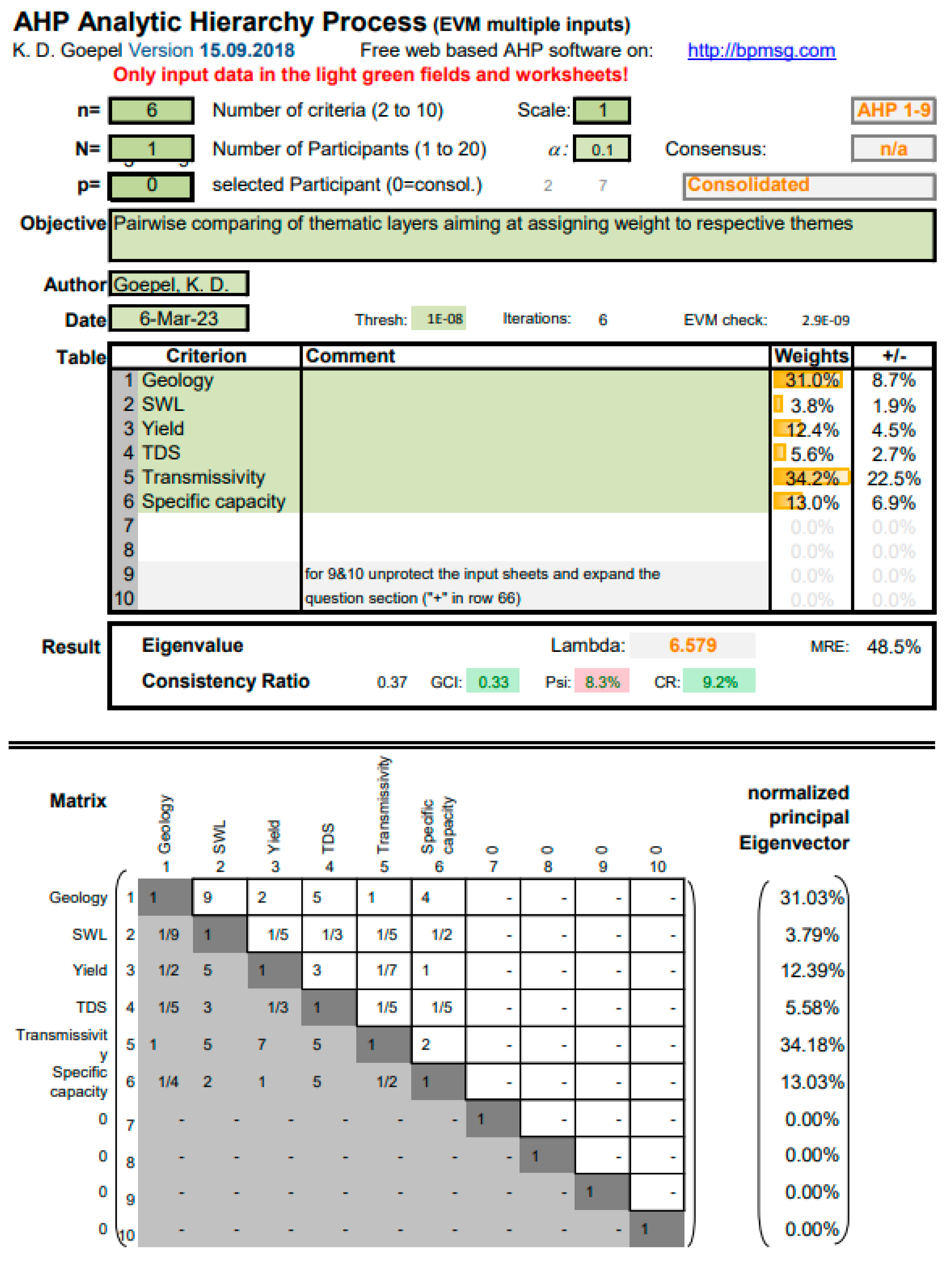
Appendix D. Hydrogeological Cross-Section
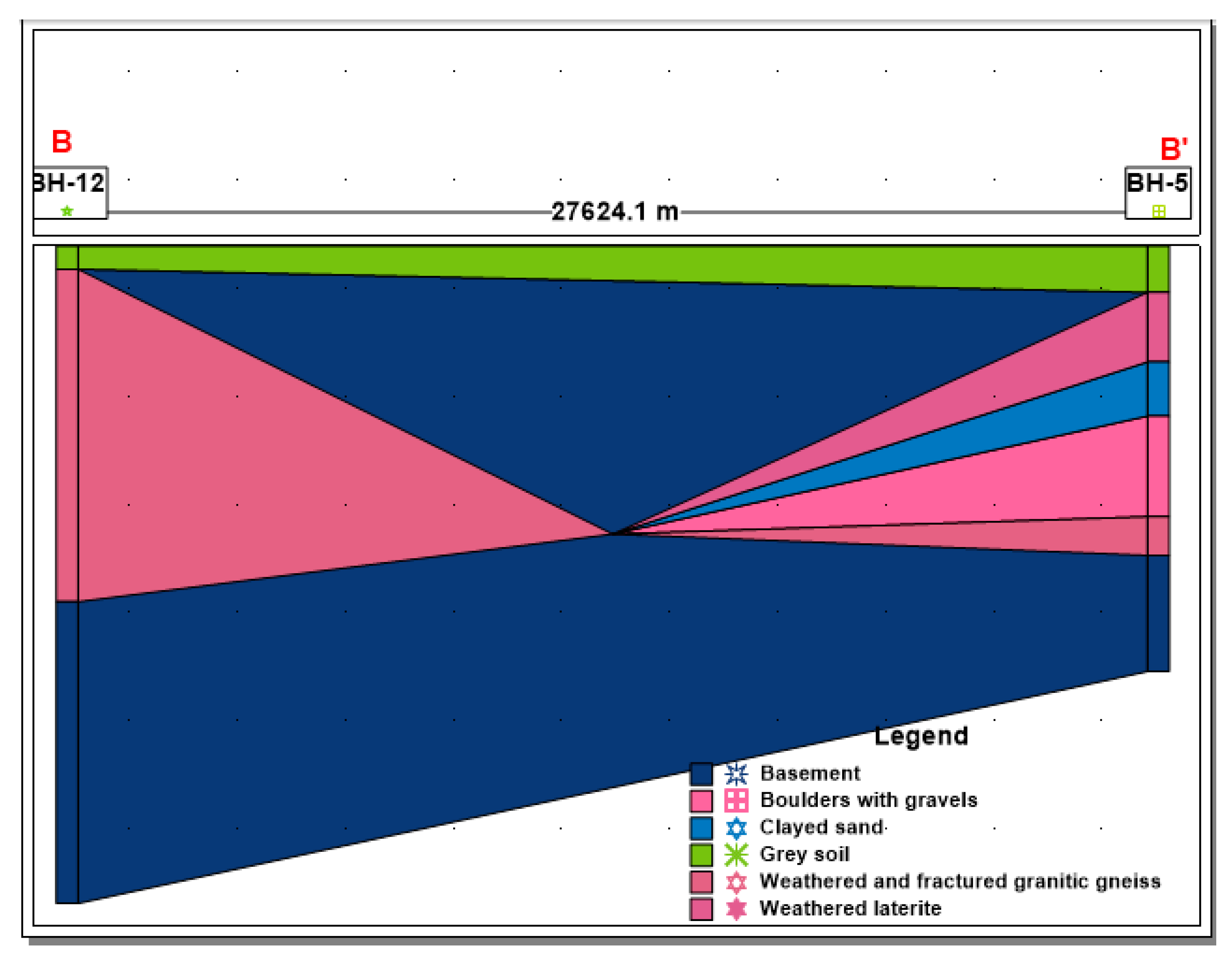

Appendix E. Lithology and Well Design
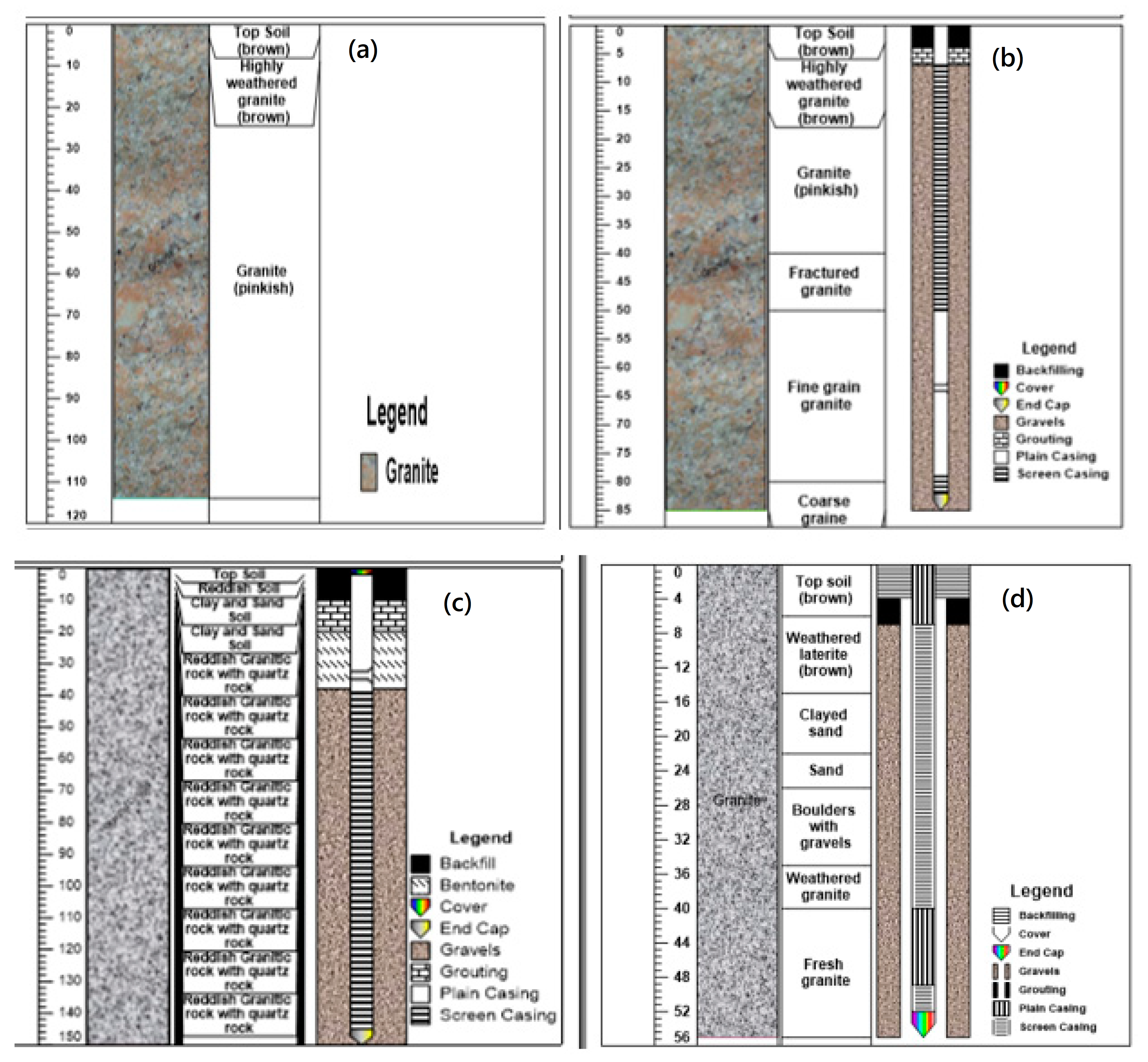
References
- United Nations Children’s Fund (UNICEF). State of the World’s Hand Hygiene: A Global Call to Action to Make Hand Hygiene a Priority in Policy and Practice; UNICEF; WHO: New York, NY, USA, 2021; ISBN 9789280652901. [Google Scholar]
- Makoba, E.; Muzuka, A.N.N. Water quality and hydrogeochemical characteristics of groundwater around Mt. Meru, Northern Tanzania. Appl. Water Sci. 2019, 9, 120. [Google Scholar] [CrossRef]
- Mjemah, I.C.; van Camp, M.; Martens, K.; Walraevens, K. Groundwater exploitation and recharge rate estimation of a quaternary sand aquifer in Dar-es-Salaam area, Tanzania. Environ. Earth Sci. 2011, 63, 559–569. [Google Scholar] [CrossRef]
- UNICEF. Progress on Sanitation and Drinking Water; UNICEF: New York, NY, USA, 2015. [Google Scholar]
- Makoba, E.; Muzuka, A.N.N. Delineation of groundwater zones with contrasting quality in the fluorotic zone, around Mount Meru, northern Tanzania. Hydrol. Sci. J. 2021, 66, 322–346. [Google Scholar] [CrossRef]
- Braune, E.; Xu, Y. The Role of Ground Water in Sub-Saharan Africa. Groundwater 2010, 48, 229–238. [Google Scholar] [CrossRef]
- Elisante, E.; Muzuka, A.N.N. Occurrence of nitrate in Tanzanian groundwater aquifers: A review. Appl. Water Sci. 2017, 7, 71–87. [Google Scholar] [CrossRef]
- Kashaigili, J.J. Assessment of Groundwater Availability and Its Current and Potential Use and Impacts in Tanzania. 2010, pp. 1–67. Available online: https://www.suaire.sua.ac.tz/handle/123456789/1484 (accessed on 2 October 2023).
- Sadiki, H. Groundwater Management in Africa: The Case of Pangani Basin, Tanzania. In Proceedings of the 5th World Water Forum, Istanbul, Turkey, 20 March 2009. [Google Scholar]
- SMEC. Integrated Water Reources Management and Development Plans for Lake Tanganyika Basin Water Board; SMEC: Kigoma, Tanzanai, 2015. [Google Scholar]
- Davies, J.; Dochartaigh, B.Ó. Visit to Undertake Groundwater Development Studies in Tabora Region Tanzania (July–September 2000); British Geological Servey: Nottingham, UK, 2000. [Google Scholar]
- JICA. Project of Rural Water Supply in Tabora Region, Tanzania; Ministry of Water: Dodoma, Tanzania, 2011.
- Popoola, A.A.A.O.I.; Ogungbe, O.T.O.A.S.; Okediji, O.A.O.S.O. Assessment of groundwater potential and quality using geophysical and physicochemical methods in the basement terrain of Southwestern, Nigeria. Environ. Earth Sci. 2020, 79, 364. [Google Scholar] [CrossRef]
- Agbede, O.A.; Oyelakin, J.; Sciences, E.; Aiyelokun, O. Evaluation of Groundwater Potential through Aquifer Hydraulic Properties in Oyo State, Southwestern Basement Complex Nigeria. In Proceedings of the 2019 Civil Engineering Conference on Sustainable Construction for National Development, Ibada, Nigeria, 10–12 July 2019. [Google Scholar]
- Kumar, T.J.R.; Balasubramanian, A.; Kumar, R.S.; Dushiyanthan, C.; Thiruneelakandan, B.; Suresh, R.; Karthikeyan, K.; Davidraju, D. Assessment of groundwater potential based on aquifer properties of hard rock terrain in the Chittar—Uppodai watershed, Tamil Nadu, India. Appl. Water Sci. 2016, 6, 179–186. [Google Scholar] [CrossRef]
- Ugbaja, A.N.; William, G.A.; Ugbaja, U.A. Evaluation of Groundwater Potential Using Aquifer Characteristics on Parts of Boki Area, South—Eastern. J. Geol. Sci. 2021, 19, 93–104. [Google Scholar] [CrossRef]
- Gomo, M. On the practical application of the Cooper and Jacob distance-drawdown method to analyse aquifer-pumping test data. Groundw. Sustain. Dev. 2020, 11, 100478. [Google Scholar] [CrossRef]
- Mawlood, D.K.; Mustafa, J.S. Cooper-Jacob’s Method for Estimating of the Aquifer Parameters. Math. Model. Civ. Eng. 2016, 12, 9–20. [Google Scholar] [CrossRef]
- Council, U.D. Medium Term Rolling Strategic Plan for. 2018. Available online: https://urambodc.go.tz (accessed on 2 October 2023).
- Mwita, M.M. Shifting Cultivation, Wood Use and Deforestation Attributes of Tobacco Farming in Urambo District, Tanzania. Curr. Res. J. Soc. Sci. 2012, 4, 135–140. [Google Scholar]
- Quansah, A.D.; Dogbey, F.; Asilevi, P.J.; Boakye, P.; Darkwah, L.; Oduro-Kwarteng, S.; Sokama-Neuyam, Y.A.; Mensah, P. Assessment of solar radiation resource from the NASA-POWER reanalysis products for tropical climates in Ghana towards clean energy application. Sci. Rep. 2022, 12, 10684. [Google Scholar] [CrossRef] [PubMed]
- Cohen, K.; Finney, S.; Gibbard, P.; Fan, J.-X. International Chronostratigraphic Chart v2016/04. Int. Comm. Stratigr. 2013, 36, 199–204. [Google Scholar]
- Davies, J.; Dochartaigh, B.E.O. Low Permeability Rocks in Sub-Saharan Africa: Groundwater Development in the Tabora Region, Tanzania; British Geological Survey: Nottingham, UK, 2002; p. 76. [Google Scholar]
- Nakayama, H.; Yamasaki, Y.; Ohashi, K.; Nakaya, S. Simple method for estimating well yield potential through geostatistical approach in fractured crystalline rock formations. J. Hydrol. 2021, 597, 125719. [Google Scholar] [CrossRef]
- Gleeson, T.; Manning, A.H. Regional groundwater flow in mountainous terrain: Three-dimensional simulations of topographic and hydrogeologic controls. Water Resour. Res. 2008, 44, W10403. [Google Scholar] [CrossRef]
- Ige, O.O.; Obasaju, D.O.; Baiyegunhi, C.; Ogunsanwo, O.; Baiyegunhi, T.L. Evaluation of aquifer hydraulic characteristics using geoelectrical sounding, pumping and laboratory tests: A case study of Lokoja and Patti Formations, Southern Bida Basin, Nigeria. Open Geosci. 2018, 10, 807–820. [Google Scholar] [CrossRef]
- Chikira, I.; Van Camp, M.; Walraevens, K. Groundwater exploitation and hydraulic parameter estimation for a Quaternary aquifer in Dar-es-Salaam Tanzania. J. African Earth Sci. 2009, 55, 134–146. [Google Scholar] [CrossRef]
- Kale, V.; Quality, W.; Roosevelt, L.; Manual, S. Water quality sampling using in situ water quality instruments 1 Purpose and scope. Int. Adv. Res. J. Sci. Eng. Technol. ISO 2008, 3297, 1–11. [Google Scholar]
- Halford, K.J.; Weight, W.D.; Schreiber, R.P. Interpretation of Transmissivity Estimates from Single-Well Pumping Aquifer Tests. Groundwater 2006, 44, 467–471. [Google Scholar] [CrossRef]
- Nwankwoala, H.O. Application of Aquifer Parameters in Evaluating Groundwater Potential of Logo Area, Benue State, Nigeria. Int. J. Environ. Sci. Nat. Resour. 2018, 11, 1–8. [Google Scholar] [CrossRef]
- Kennedy, O.A. Hydrogeophysical studies for the determination of aquifer hydraulic characteristics and evaluation of groundwater potential: A case study of some selected parts of Imo River Basin, South Eastern Niger. Int. J. Sci. Res. Publ. 2020, 10, 738–755. [Google Scholar] [CrossRef]
- Hasan, M.; Shang, Y.; Akhter, G.; Jin, W. Geophysical Assessment of Groundwater Potential: A Case Study from Mian Channu Area, Pakistan. Groundwater 2018, 56, 783–796. [Google Scholar] [CrossRef] [PubMed]
- Krásný, J. Classification of Transmissivity Magnitude and Variation. Groundwater 1993, 31, 230–236. [Google Scholar] [CrossRef]
- Sapkota, S.; Prasad, V.; Bhattarai, U.; Panday, S. Groundwater potential assessment using an integrated AHP-driven geospatial and field exploration approach applied to a hard-rock aquifer Himalayan watershed. J. Hydrol. Reg. Stud. 2021, 37, 100914. [Google Scholar] [CrossRef]
- WHO. Guidelines for Drinking-Water Quality; WHO: Geneva, Switzerland, 2022; Volume 33, ISBN 9789240045064. [Google Scholar]
- Oberlin, A.S.; Ntoga, S. Quality Assessment of Drinking Water in Sumve Kwimba District. Am. J. Eng. Res. 2018, 7, 26–34. [Google Scholar]
- MacDonald, A.; Bonsor, H.; Calow, R.; Taylor, R.; Lapworth, D.; Maurice, L.; Tucker, J.; Dochartaigh, B. Groundwater Resilience to Climate Change in Africa; British Geological Survey Open Report: OR/11/031; British Geological Survey: Nottingham, UK, 2011; pp. 1–24. Available online: http://nora.nerc.ac.uk/id/eprint/15772/1/OR11031.pdf (accessed on 2 October 2023).
- Herschy, R.W. Water Quality for Drinking: WHO guidelines. In Encyclopedia of Lakes and Reservoirs; Springer: Dordrecht, The Netherlands, 2012; pp. 876–883. [Google Scholar] [CrossRef]
- Meride, Y.; Ayenew, B. Drinking water quality assessment and its effects on residents health in Wondo genet campus, Ethiopia. Environ. Syst. Res. 2016, 5, 1. [Google Scholar] [CrossRef]
- Lehigh University. Total Dissolved Solids. EnviroSci Inquiry. Available online: https://ei.lehigh.edu/envirosci/watershed/wq/wqbackground/tdsbg.html#:~:text=2.-,Concentration%20of%20total%20dissolved%20solids%20that%20are%20too%20high%20or,an%20increase%20in%20water%20temperature (accessed on 2 October 2023).
- Testing for Total Dissolved Solids. Available online: www.epa.gov/safewater/consumer/pdf/ (accessed on 2 October 2023).
- Adjovu, G.E.; Stephen, H.; James, D.; Ahmad, S. Measurement of Total Dissolved Solids and Total Suspended Solids in Water Systems: A Review of the Issues, Conventional, and Remote Sensing Techniques. Remote Sens. 2023, 15, 3534. [Google Scholar] [CrossRef]
- Acharya, T.; Prasad, R. Hydrodynamic Study of Weathered Zone of Hardrock Aquifers Using Dugwell Data. Nat. Resour. Res. 2014, 23, 331–340. [Google Scholar] [CrossRef]
- Kubingwa, J.N.; Makoba, E.E.; Mussa, K.R. Integrated Geospatial and Geophysical Approaches for Mapping Groundwater Potential in the Semi-Arid Bukombe District, Tanzania. Earth 2023, 4, 241–265. [Google Scholar] [CrossRef]
- Nayak, S.; Mukhopadhyay, B.P.; Mitra, A.K.; Chakraborty, R. Structural control on the occurrence of groundwater in granite gneissic terrain, Purulia, West Bengal. Arab. J. Geosci. 2020, 13, 955. [Google Scholar] [CrossRef]

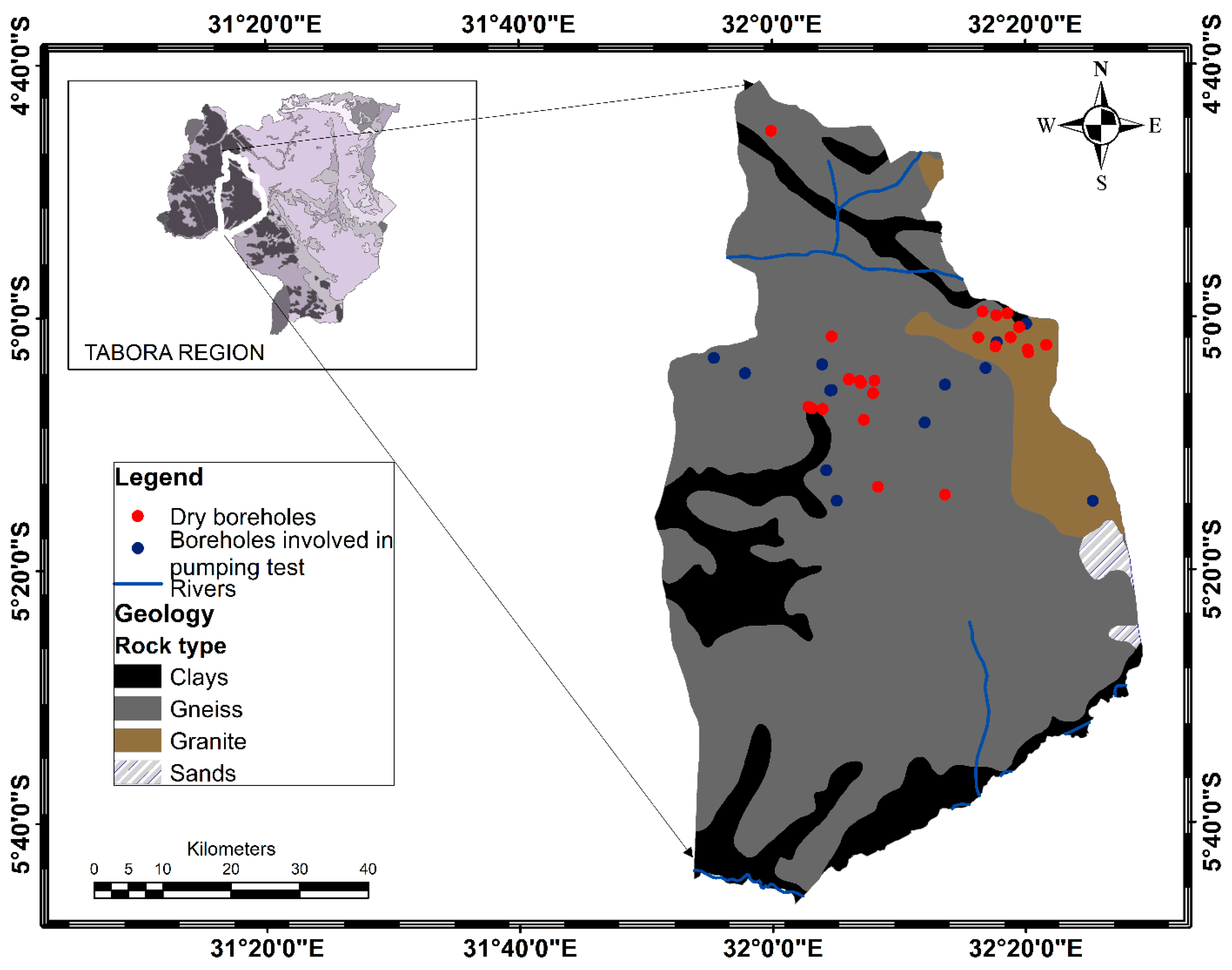
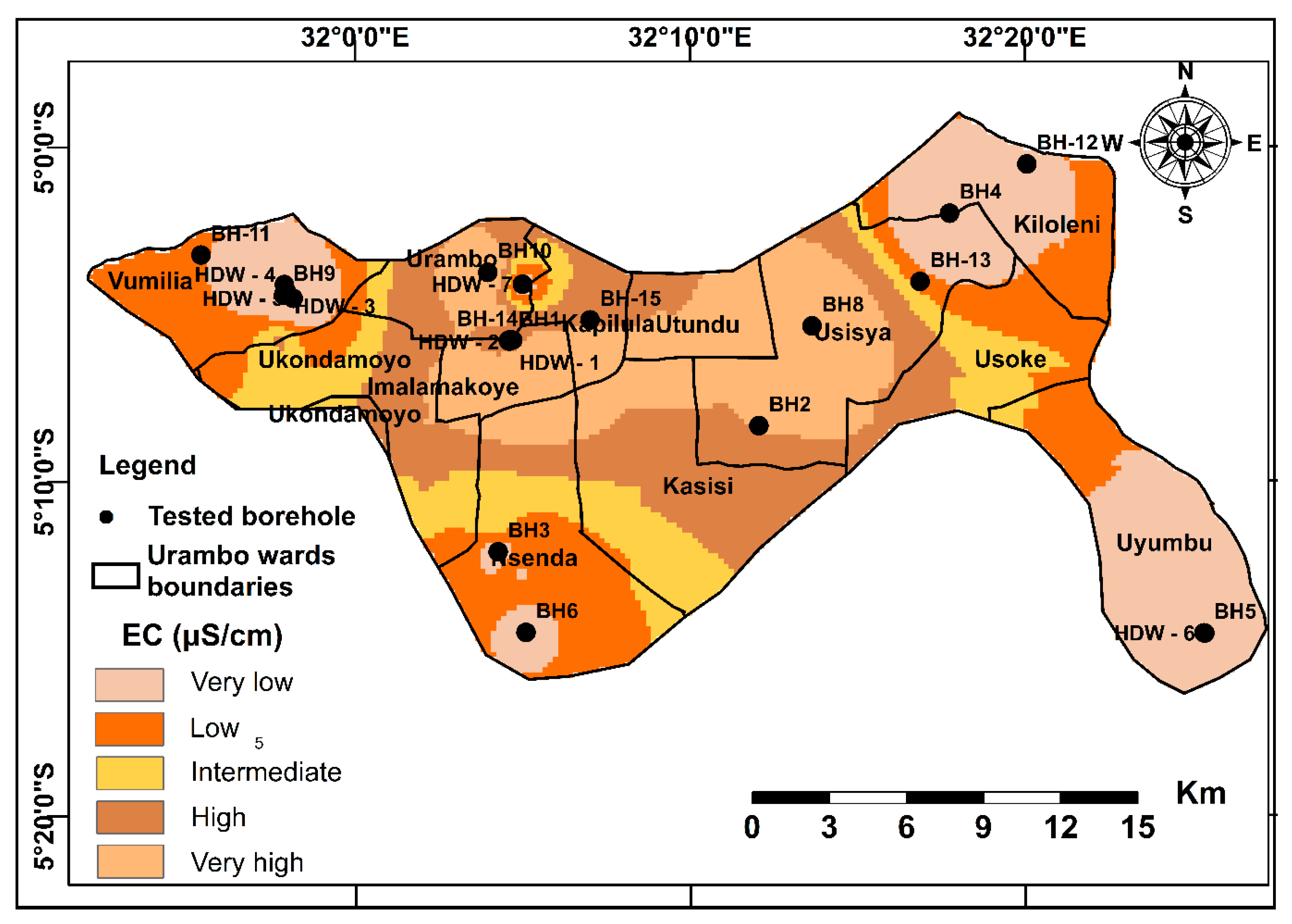
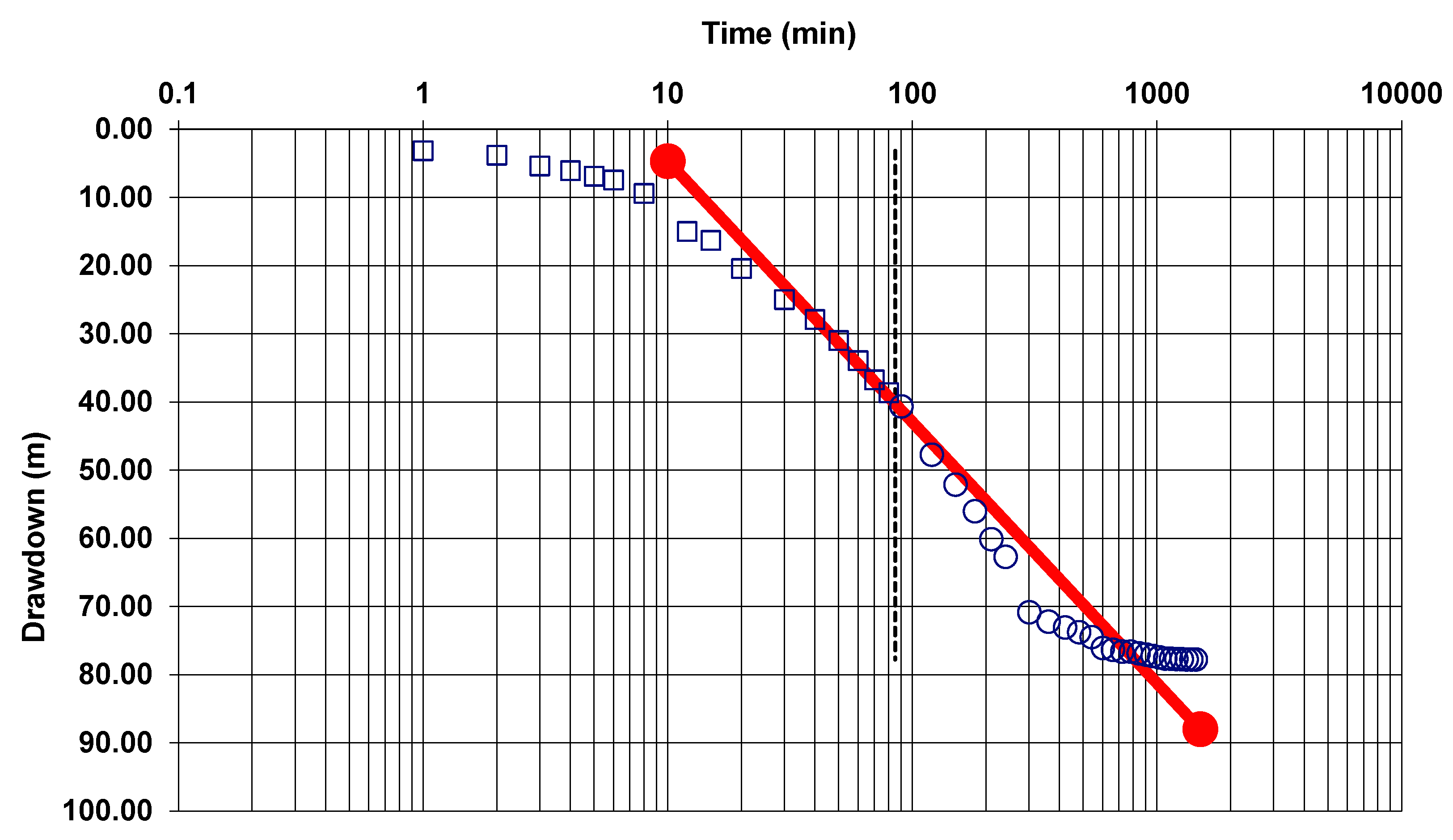
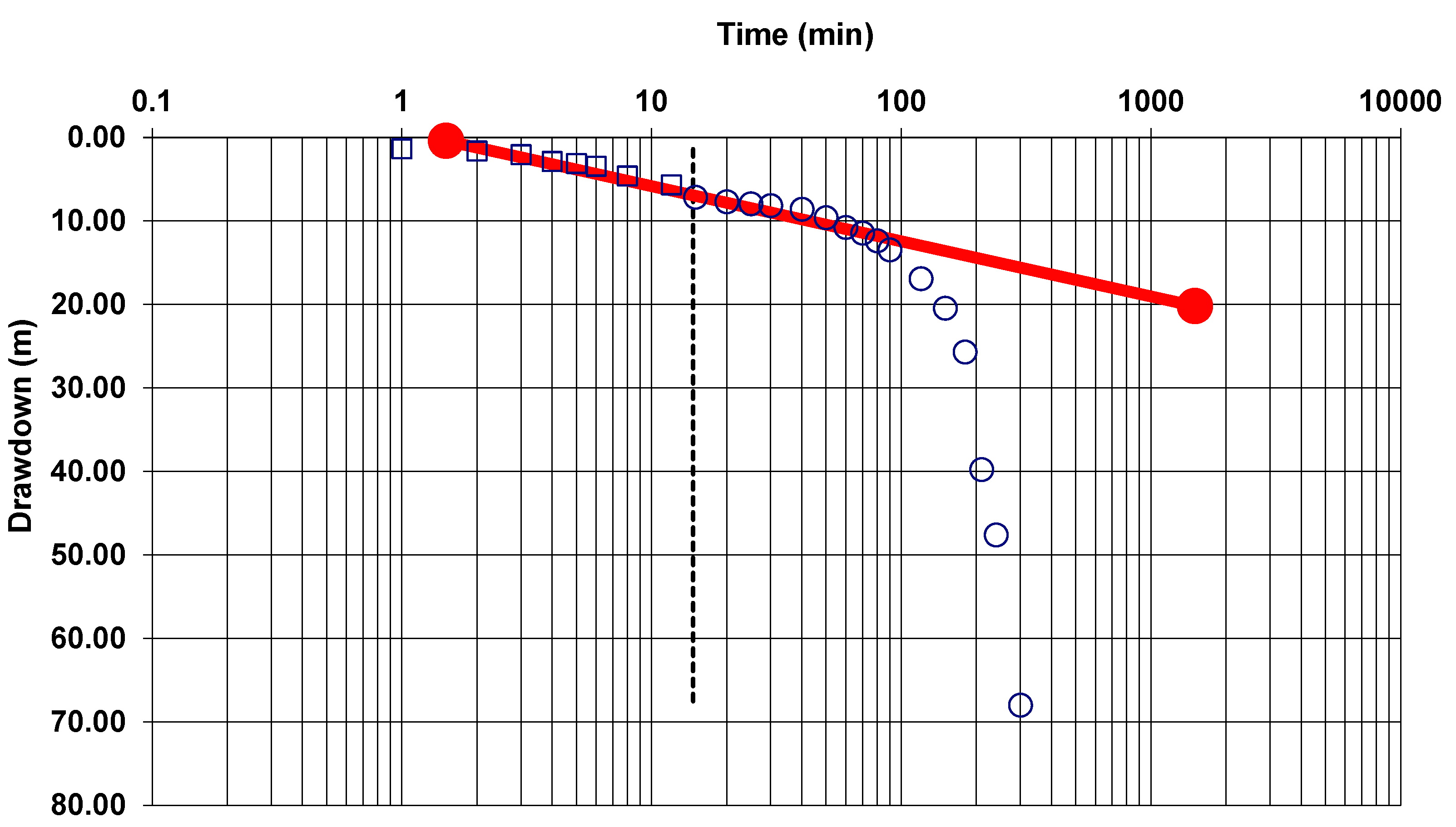
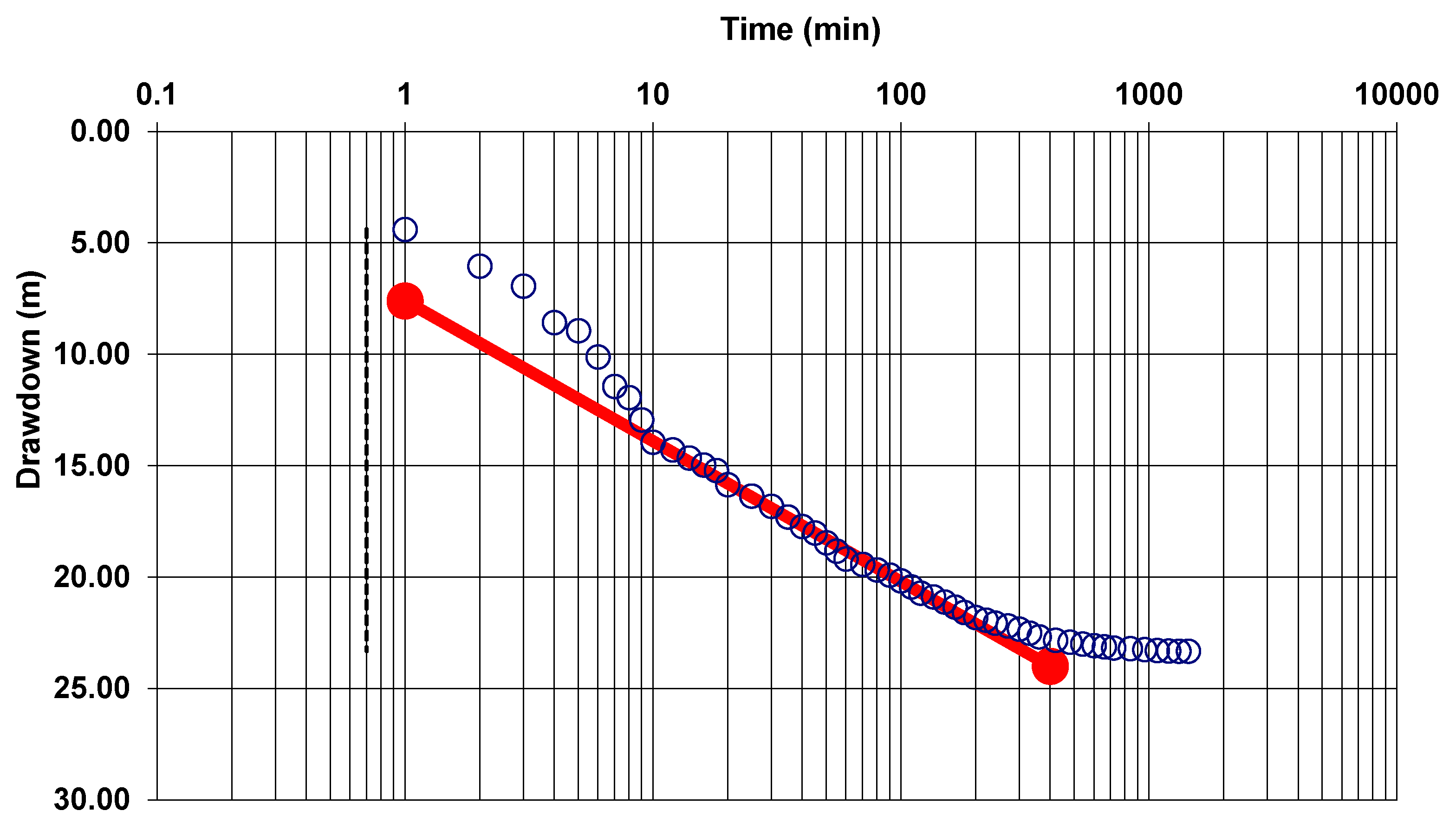
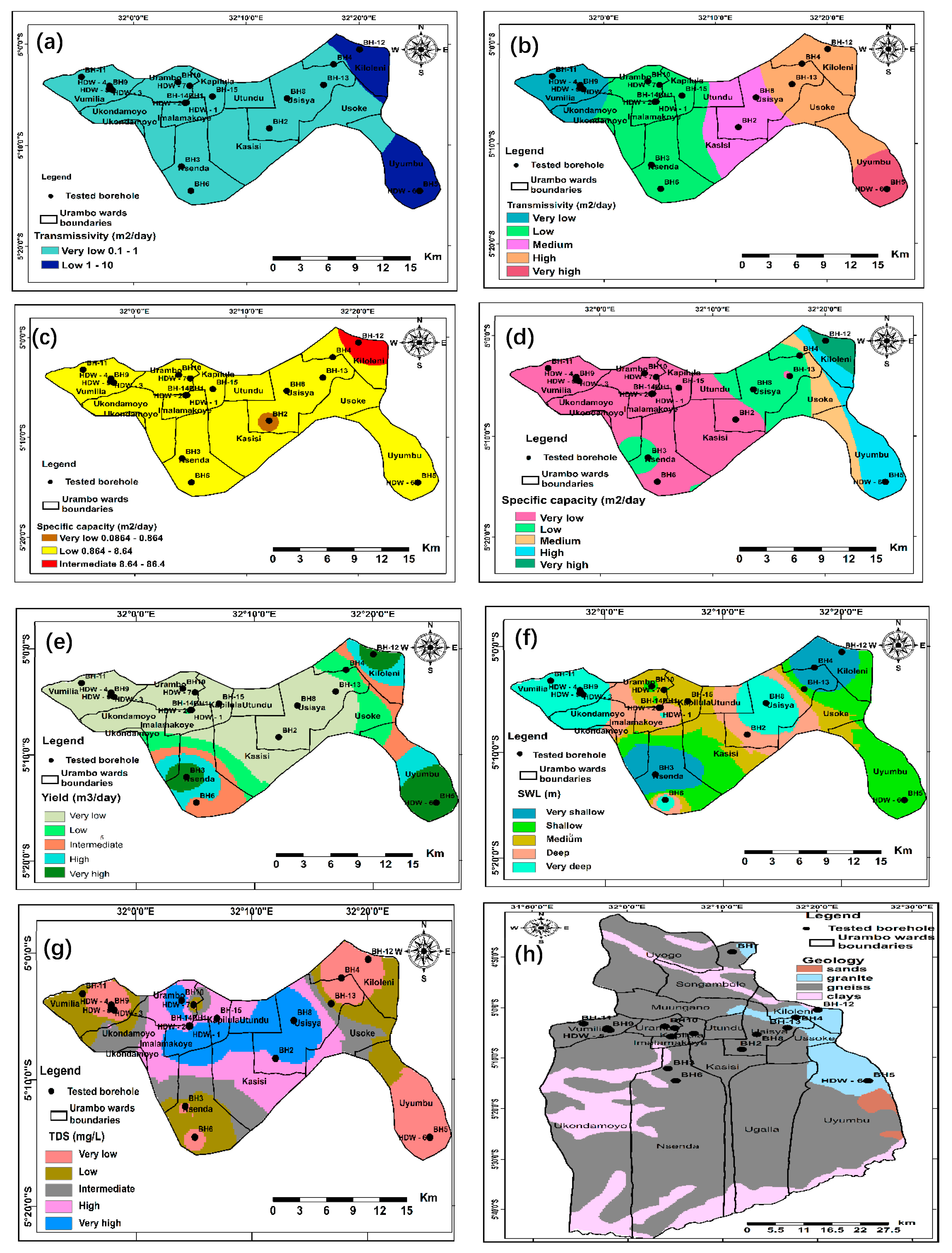

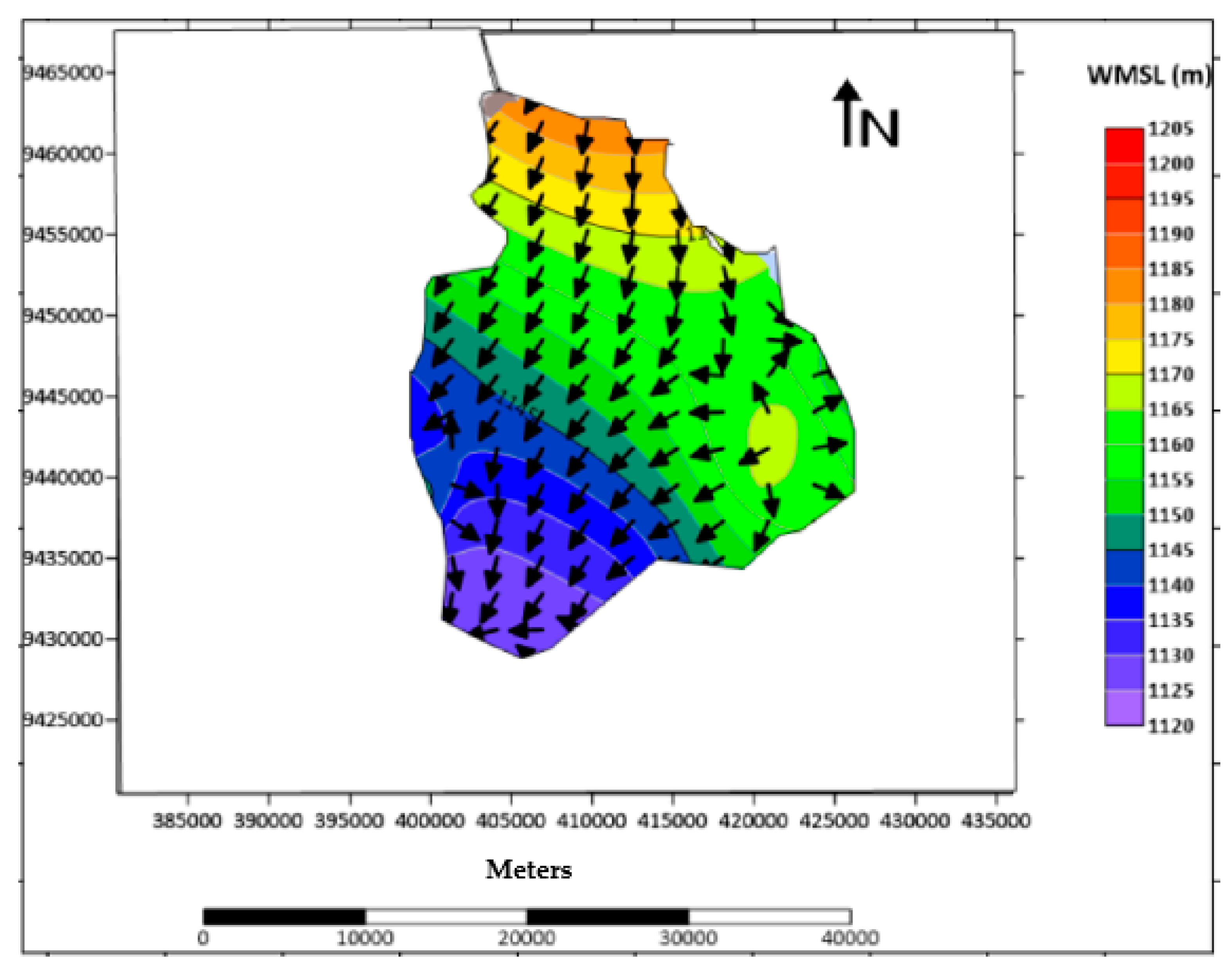



| Month | PET (mm/Month) | PPT (mm/Month) | TMax (°C) | TMin (°C) | TMean (°C) | Aridity Index | Aridity Status |
|---|---|---|---|---|---|---|---|
| January | 212 | 156 | 37 | 15 | 26 | 0.74 | Humid |
| February | 213 | 141 | 37 | 14 | 25 | 0.66 | Humid |
| March | 210 | 142 | 36 | 15 | 26 | 0.68 | Humid |
| April | 198 | 113 | 35 | 15 | 25 | 0.57 | Dry sub-humid |
| May | 200 | 25 | 34 | 12 | 23 | 0.12 | Arid |
| June | 203 | 7 | 34 | 11 | 22 | 0.03 | Hyper-arid |
| July | 205 | 2 | 34 | 10 | 22 | 0.01 | Hyper-arid |
| August | 214 | 4 | 36 | 12 | 24 | 0.02 | Hyper-arid |
| September | 226 | 11 | 38 | 14 | 26 | 0.05 | Hyper-arid |
| October | 223 | 39 | 38 | 16 | 27 | 0.17 | Arid |
| November | 218 | 159 | 38 | 16 | 27 | 0.73 | Humid |
| December | 204 | 199 | 35 | 14 | 25 | 0.97 | Hyper-humid |
| Total | 2525 | 997 | |||||
| Average | 210 | 83 | 36 | 14 | 25 | 0.40 | SEMI-ARID |
| S/N | Aridity Index (AI) Values (Thornthwaite Method) | Climate Classification |
|---|---|---|
| 1 | AI < 0.05 | Hyper-arid |
| 2 | 0.05 < AI < 0.2 | Arid |
| 3 | 0.2 < AI < 0.5 | Semi-arid |
| 4 | 0.5 < AI < 0.65 | Dry sub-humid |
| 5 | 0.65 < AI < 0.75 | Humid |
| 6 | >0.75 | Hyper-humid |
| Classification | Description | Range of ‘Y’ of Studied Area |
|---|---|---|
| Negative extreme anomalies | Less than [mean—(2 * standard deviation)] | <[mean—(2 * standard deviation)] |
| Negative anomalies | Between (mean—standard deviation) and [mean—(2 * standard deviation)] | Between (mean—standard deviation) and [mean—(2 * standard deviation)] |
| Background anomalies | Between (mean—standard deviation) and (mean + standard deviation) | Between (mean—standard deviation) and (mean + standard deviation) |
| Positive anomalies | Between (mean + standard deviation) and mean + (2 * standard deviation | Between (mean + standard deviation) and mean + (2 * standard deviation |
| Positive extreme anomalies | Greater than [mean + (2 * standard deviation)] | >[mean + (2 * standard deviation)] |
| Magnitude of Transmissivity (m2/Day) | Class | Status | Specific Capacity (m2/Day) | Groundwater Supply Potential |
|---|---|---|---|---|
| >1000 | I | Very High | >864 | Withdrawals of great regional importance |
| 100–1000 | II | High | 86.4–864 | Withdrawals of less regional importance |
| 10–100 | III | Intermediate | 8.64–86.4 | Withdrawal for local water supply (small communities and plants) |
| 1–10 | IV | Low | 8.64-0.864 | Small withdrawal for local water supply (private consumption) |
| 0.1–1 | V | Very low | 0.0864–0.864 | Withdrawal for local water supply with limited consumption |
| <0.1 | VI | Imperceptible | <0.0864 | Sources of local water supply are limited |
| Standard Deviation of Transmissivity Index (Y) | Class of Transmissivity Variation | Status of Transmissivity Variation | Hydrogeological Environment |
|---|---|---|---|
| <0.2 | a | Insignificant | Homogenous |
| 0.2–0.4 | b | Small | Slightly heterogeneous |
| 0.4–0.6 | c | Moderate | Fairly heterogenous |
| 0.6–0.8 | d | Large | Considerably heterogenous |
| 0.8–1.0 | e | Very large | Very heterogenous |
| >1.0 | f | Extremely large | Extremely heterogenous |
| Well | Location | Water Source | Water Quality Parameter | ||||
|---|---|---|---|---|---|---|---|
| Temp. | pH | EC | TDS | Turbidity | |||
| (°C) | (µS/cm) | (mg/L) | (NTU) | ||||
| BH-1 | Masaki | BH | 26.9 | 7.67 | 1393 | 902 | 14.8 |
| BH-2 | Katunguru | BH | 30.9 | 7.74 | 1765 | 1142 | 0 |
| BH-3 | Itebulanda | BH | 24.8 | 8.2 | 356 | 230 | 0 |
| BH-4 | Kalembela | BH | 25.7 | 8.1 | 132 | 85 | 176 |
| BH-5 | Izimbili | BH | 27.6 | 8.53 | 132 | 85 | 218 |
| BH-6 | Utenge (Mkola) | BH | 27.9 | 8.04 | 439 | 285 | 7.3 |
| BH-7 | Kichangani (Ukwanga) | BH | 29 | 7.8 | 88 | 57 | 46.1 |
| BH-8 | Usisya | BH | 25.2 | 7.6 | 1765 | 1142 | 0 |
| BH-9 | Motomoto | BH | 26.1 | 8.1 | 1022 | 662 | 19.9 |
| BH-10 | Extended P/School | BH | 28.9 | 7.74 | 401 | 262 | 0 |
| BH-13 | Sipungu | BH | 25 | 7.1 | 590 | 286 | 30 |
| BH-12 | Kiloleni | BH | 7.21 | 440 | 286 | 15 | |
| BH-14 | Imalamakoye | BH | 6.6 | 62.9 | 2.1 | ||
| BH-15 | Kapilula | BH | 6.4 | 60.4 | 3 | ||
| BH-16 | Itebulanda P/School | BH | 26.3 | 8.04 | 247 | 162 | 0 |
| BH-17 | Itebulanda Dispensary | BH | 24.9 | 7.7 | 917 | 594 | 17.5 |
| BH-18 | Nsenda Kanoge | BH | 26.3 | 7.64 | 972 | 627 | 7.3 |
| HDW -1 | Masaki | HDW | 25.6 | 7.7 | 491 | 319 | 150 |
| HDW -2 | Masaki | HDW | 26.3 | 7.4 | 855 | 553 | 39.2 |
| BH-19 | Block | BH | 28.8 | 7.72 | 1552 | 931 | 10.3 |
| HDW-3 | Motomoto | HDW | 26.3 | 7.8 | 294 | 191 | 27.5 |
| HDW-4 | Motomoto | HDW | 27.1 | 7.73 | 261 | 169 | 26.1 |
| HDW-5 | Motomoto | HDW | 27.7 | 7.58 | 228 | 148 | 51.9 |
| HDW-6 | Izimbili | HDW | 27 | 8 | 331 | 213 | 23.1 |
| HDW-7 | Mwenge | HDW | 28.9 | 7.74 | 401 | 262 | 0 |
| BH-20 | Usoke | BH | 27.1 | 6.83 | 523 | 302 | 17 |
| BH-21 | Imalamakoye W/Supply | BH | 27 | 7.79 | 3762 | 2445 | 8.3 |
| BH-22 | Ukimbizini W/Supply | BH | 27.6 | 7.4 | 2092 | 1359 | 0.5 |
| HDW-8 | Kiloleni | HDW | 7.23 | 95.5 | 61.8 | 9 | |
| Max. | 30.9 | 8.5 | 3762 | 2445 | 218 | ||
| Min. | 24.8 | 6.4 | 60 | 57 | 0 | ||
| Stdev | 1.5 | 0.5 | 815 | 533 | 54 | ||
| Median | 27 | 7.7 | 439 | 286 | 15 | ||
| Mean | 27 | 7.6 | 770 | 527 | 33 | ||
| Mean ± STD | 27 ± 1.5 | 7.6 ± 0.5 | 770 ± 815 | 527 ± 533 | 33 ± 54 | ||
| WHO (STD) | Nm | 6.5–8.5 | 120 | 750 | 5 | ||
| TBS (STD) | Nm | 6.5–9.2 | 1000 | 500 | 5–25 | ||
| BH | SWL (m) | Depth (m) | Yield (m3/d) | Drawdown (m) | Sc (m2/d) | T (m2/d) | Y (m2/d) | Range of ‘Y’ |
|---|---|---|---|---|---|---|---|---|
| BH-1 | 3.53 | 150 | 61.3 | 16.66 | 3.68 | 0.7 | 3.87 | 3.12–4.52 |
| BH-2 | 3.4 | 100 | 12.7 | 44.27 | 0.29 | 0.1 | 3.02 | 2.42–3.12 |
| BH-3 | 1.56 | 102 | 108 | 34.97 | 3.09 | 0.6 | 3.80 | 3.12–4.52 |
| BH-4 | 0.6 | 95 | 44.45 | 38.46 | 1.16 | 0.2 | 3.32 | 3.12–4.52 |
| BH-5 | 4.28 | 55 | 108 | 12.94 | 8.35 | 1.5 | 4.20 | 3.12–4.52 |
| BH-6 | 6.34 | 130 | 62.4 | 27.4 | 2.28 | 0.4 | 3.63 | 3.12–4.52 |
| BH-7 | 1.06 | 27 | 52.8 | 7.38 | 7.15 | 1.3 | 4.14 | 3.12–4.52 |
| BH-8 | 7.97 | 50 | 24 | 4.47 | 5.37 | 1 | 4.02 | 3.12–4.52 |
| BH-9 | 2.1 | 83 | 33.48 | 17.25 | 1.94 | 0.4 | 3.63 | 3.12–4.52 |
| BH-10 | 7.1 | 64 | 31.68 | 21.78 | 1.45 | 0.3 | 3.50 | 3.12–4.52 |
| BH-11 | 2.2 | 90 | 32.76 | 36.9 | 0.89 | 0.2 | 3.32 | 3.12–4.52 |
| BH-12 | 1.6 | 85 | 108 | 6.6 | 16.36 | 3 | 4.5 | 3.12–4.52 |
| BH-13 | 2.35 | 150 | 28.8 | 17.44 | 1.65 | 0.3 | 3.5 | 3.12–4.52 |
| BH-14 | 1.89 | 132 | 10.08 | 10.27 | 0.98 | 0.18 | 3.28 | 3.12–4.52 |
| BH-15 | 6.03 | 77.88 | 11.52 | 8.39 | 1.37 | 0.22 | 3.37 | 3.12–4.52 |
| Mean | 20.35 | 0.69 | 3.82 | |||||
| Standard Deviation | 0.70 |
| Theme | Weight (%) | Class | Class Description | Rank |
|---|---|---|---|---|
| SWL | 3.79 | 1 | 0.60–2.23 | 9 |
| 2 | 2.23–3.24 | 8 | ||
| 3 | 3.24–4.05 | 7 | ||
| 4 | 4.05–5.11 | 6 | ||
| 5 | 5.11–7.97 | 5 | ||
| Yield | 12.39 | 1 | 11.6–30.8 | 5 |
| 2 | 30.8–42.9 | 6 | ||
| 3 | 42.9–57.3 | 7 | ||
| 4 | 57.3–77.0 | 8 | ||
| 5 | 77.0–108.0 | 9 | ||
| TDS | 5.58 | 1 | 57.05–344.71 | 5 |
| 2 | 344.71–539.59 | 6 | ||
| 3 | 539.59–715.91 | 7 | ||
| 4 | 715.91–938.62 | 8 | ||
| 5 | 938.62–2423.38 | 9 | ||
| Transmissivity | 34.18 | 1 | 0.1–0.58 | 5 |
| 2 | 0.58–1.04 | 6 | ||
| 3 | 1.04–1.64 | 7 | ||
| 4 | 1.64–2.29 | 8 | ||
| 5 | 2.29–3.00 | 9 | ||
| SC | 13.03 | 1 | 0.29–3.06 | 5 |
| 2 | 3.06–5.71 | 6 | ||
| 3 | 5.71–8.99 | 7 | ||
| 4 | 8.99–12.52 | 8 | ||
| 5 | 12.52–16.36 | 9 | ||
| Geology | 31.03 | 1 | Sands | 9 |
| 2 | Weathered/fractured gneiss | 7 | ||
| 3 | Weathered/fractured granite | 8 | ||
| 4 | Clay | 2 |
Disclaimer/Publisher’s Note: The statements, opinions and data contained in all publications are solely those of the individual author(s) and contributor(s) and not of MDPI and/or the editor(s). MDPI and/or the editor(s) disclaim responsibility for any injury to people or property resulting from any ideas, methods, instructions or products referred to in the content. |
© 2023 by the authors. Licensee MDPI, Basel, Switzerland. This article is an open access article distributed under the terms and conditions of the Creative Commons Attribution (CC BY) license (https://creativecommons.org/licenses/by/4.0/).
Share and Cite
Yohana, A.R.; Makoba, E.E.; Mussa, K.R.; Mjemah, I.C. Evaluation of Groundwater Potential Using Aquifer Characteristics in Urambo District, Tabora Region, Tanzania. Earth 2023, 4, 776-805. https://doi.org/10.3390/earth4040042
Yohana AR, Makoba EE, Mussa KR, Mjemah IC. Evaluation of Groundwater Potential Using Aquifer Characteristics in Urambo District, Tabora Region, Tanzania. Earth. 2023; 4(4):776-805. https://doi.org/10.3390/earth4040042
Chicago/Turabian StyleYohana, Athuman R., Edikafubeni E. Makoba, Kassim R. Mussa, and Ibrahimu C. Mjemah. 2023. "Evaluation of Groundwater Potential Using Aquifer Characteristics in Urambo District, Tabora Region, Tanzania" Earth 4, no. 4: 776-805. https://doi.org/10.3390/earth4040042
APA StyleYohana, A. R., Makoba, E. E., Mussa, K. R., & Mjemah, I. C. (2023). Evaluation of Groundwater Potential Using Aquifer Characteristics in Urambo District, Tabora Region, Tanzania. Earth, 4(4), 776-805. https://doi.org/10.3390/earth4040042







